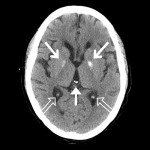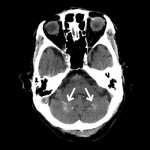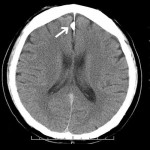Intracranial calcifications are frequently seen in non-contrast CT scans. These are often due to age-related physiological changes of the brain but can occasionally be mistaken as an intra-cerebral hemorrhage. The most common sites of intracranial calcifications include the basal ganglia (often bilateral, ![]() Figure 1), pineal gland
Figure 1), pineal gland ![]() (Figure 1), choroid plexus (often bilateral,
(Figure 1), choroid plexus (often bilateral,![]() Figure 1), dentate nucleus of the cerebellum (often bilateral,
Figure 1), dentate nucleus of the cerebellum (often bilateral, ![]() Figure 2) as well as the falx cerebri
Figure 2) as well as the falx cerebri ![]() (Figure 3).
(Figure 3).
There are however, situations where differentiation between calcification and blood product maybe difficult. In such circumstances, delineating the Hounsfield unit (HU) of the particular hyper-density and comparing it to that of bone would be useful. The HU of air is -1000; fat -50; CSF +15; brain +40; blood +100 and bone +1000. If any doubt, a Radiologist should be consulted for advice and interpretation of the CT scan.
It should also be noted that bilateral basal calcifications are also seen in patients with endocrine disorders (e.g. hypo and hyperparathyroidism, hypothyroidism), mitochondrial diseases as well as Fahr disease (a rare autosomal disorder characterised by basal ganglia and extra-ganglionic calcifications, parkinsonism and neuropsychiatric symptoms). These disorders should be considered and screened for if the degree of basal ganglia calcification is disproportionate to that expected for the subject’s age or if the patient’s presentation raises clinical suspicion.
- Figure 1
- Figure 2
- Figure 3
 HKU E-learning Platform in Clinical Neurosciences HKU eLearning Platform in Clinical Neurosciences
HKU E-learning Platform in Clinical Neurosciences HKU eLearning Platform in Clinical Neurosciences



